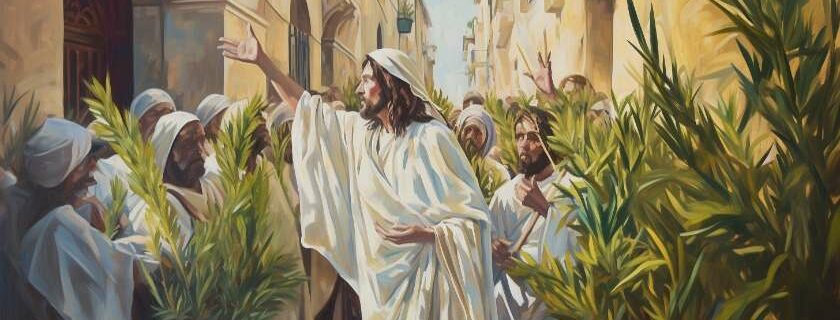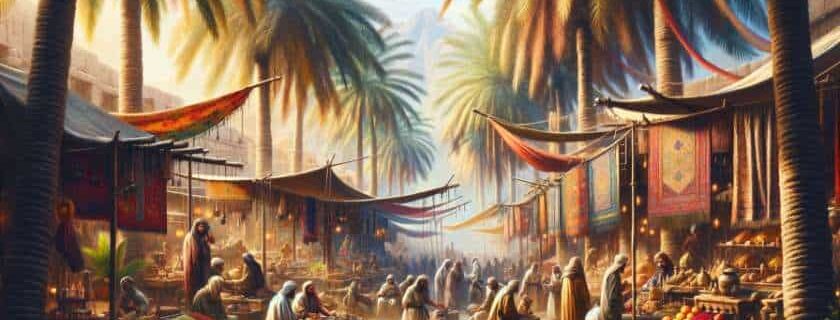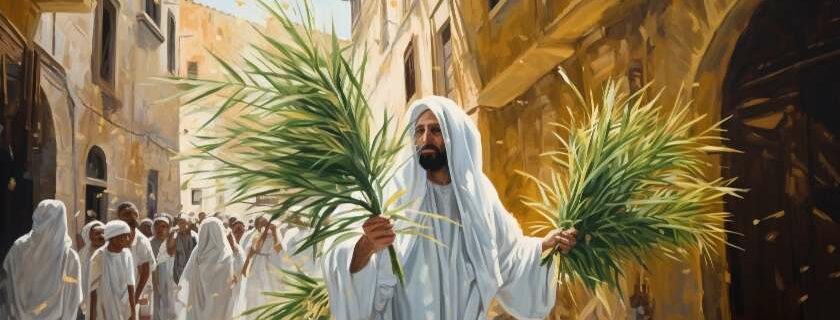Palm Sunday marks the beginning of Holy Week, seven days that conclude the day before Easter Sunday. Palm Sunday is characterized by the blessing and distribution of palm branches to the believers.
When Palm Sunday comes, Catholics worldwide carry palms as they walk in a procession inside the church. During the Lenten season, some craft palm branch crosses to pin in their pews, while others hang them as ornaments on doors and windows.
Palm branches are symbolic and meaningful on Palm Sunday. Its essence can be traced back to a thriving Jewish tradition and a rich Christian history. People raise palm branches from all over the world to commemorate the triumphal entry of Jesus Christ into Jerusalem. Palm branches were regarded as symbols of victory and triumph at the time.
Key Takeaways
- Palm branches symbolize victory, triumph, and eternal peace, representing the spiritual salvation Jesus Christ provided through his sacrifice.
- The tradition of using palm branches on Palm Sunday commemorates Jesus’ triumphal entry into Jerusalem, reflecting the joy and expectation of the people who greeted him.
- Palm branches hold a significant place in Christian history and rituals, especially during Palm Sunday and Holy Week, symbolizing both the celebration of Jesus as a savior and the anticipation of his second coming.
Contents
What Are Palm Branches?
Palm branches[1] are palm leaves with stalks that are used as a symbol of victory or joy. Traditionally, the palm branches carried on Palm Sunday symbolize the triumphal entry of Jesus into Jerusalem.
The entrance of Jesus is described in all four gospels (Matthew 21:1–11; Mark 11:1–11; Luke 19:28–34; and John 12:12–15). This became a historical event that Christians have commemorated every year since.
On that day, Jesus rode into Jerusalem on the back of a borrowed donkey colt, the first time it had been ridden. The disciples spread their cloaks on the donkey for Jesus to sit on, and crowds gathered to greet Him, laying their cloaks and palm tree branches before Him.
As He rode to the temple, the people hailed and praised Him as the “King who comes in the name of the Lord,” and He taught them, healed them, and drove out the money-changers and merchants who had turned His Father’s house into a “den of robbers” (Mark 11:17).
To fulfill an Old Testament prophecy, Jesus rode into Jerusalem and publicly declared Himself to be their Messiah and King of Israel. When the people of Israel learned that Jesus was approaching Jerusalem, they cut and used palm branches to greet him. Following Jesus, they threw their clothes on the road and waved palm leaves.
The crowds yelled memorable phrases like “Hosanna to the Son of David! Blessed is He who comes in the Lord’s name! Hosanna in the highest!” Hosanna means “save us now” or “save us, we pray.” The crowd chanted, “Save us!” as they waved palm branches to honor Jesus. Their cries of “Hosanna in the highest” expressed hope that their Messiah had finally arrived to establish God’s kingdom there and then.
They had no idea that Jesus had come to save them, but not in the way they expected. They were unaware that Christ’s entrance signaled the start of His atonement for their sins. “There is no forgiveness without the shedding of blood” (Hebrews 9:22). God provided spiritual salvation from the bonds of sin, which the Lord Jesus Christ paid dearly for.

What Is The Significance Of The Palm Branch?
A palm branch represents victory. As a result, in the account of Jesus’ arrival, the people celebrated with palm branches. Though the Jews expected a triumphant act, their expectations were not the same as the jubilation of salvation that Jesus gave us, the highest victory we can receive.
Palm trees are abundant in Israel and have been mentioned numerous times in the Bible in connection with significant historical events. Deborah, one of Israel’s judges, for example, held court sessions under the shade of palm branches (Judges 4:5). “King Solomon carved the walls of the temple, both inner and outer sanctuaries, with figures of palm trees, cherubim, and open flowers,” according to the Bible (1 Kings 6:29).
After God delivered the Israelites from slavery in Egypt, the palm tree and its branches became an important symbol of victory for Israel. After Israel escaped from Egypt, the Lord commanded that they hold a feast to commemorate their freedom from the hands of their captors, who had enslaved them for hundreds of years.
From then on, the Israelites observed the Feast of Tabernacles, which lasted seven days. Throughout this period, the Israelites lived in booths made of palm branches, leafy tree boughs, and brook willows (Leviticus 23:40–43). During the Feast of Tabernacles, palm branches were always carried.
Why Are Palm Branches Used On Palm Sunday?
Palm branches used on Palm Sunday marked the end of the Lenten season and the start of Holy Week. Holy Week is the week preceding Easter that commemorates Jesus’ final days before He was crucified.
The use of palm branches on Palm Sunday commemorates Jesus Christ’s triumphal entry into Jerusalem, where he was greeted by people waving palm branches. We see the procession of our King, who did everything he could to atone for our sins and save us.
For Christians, palm branches represent Jesus’ victory and triumph over death. It reminds us of how we welcomed Jesus into our hearts and how eager we are to follow him. The ceremony is never complete without the waving and decorating of palm branches.

Palm Branches In Ancient Times
Palm branches in ancient times represented faithfulness, splendor, triumph, virtue, and welfare. They are depicted on coins and in important buildings. Palm leaves have symbolized victory with honor, peace, and eternal life throughout eons and cultures.
Palm trees were an essential part of the ancient Jewish people’s world. They were valuable resources for building materials, shade, and beauty. They even supplied food in the form of delectable dates. They were so ingrained in the landscape that the first city the children of Israel conquered upon entering the Promised Land was Jerico, also known as “the city of palm trees” in the Bible (Deut. 34:3; 2 Chron. 28:15).
King Solomon had palm branches carved into the temple’s walls and doors: “He carved cherubim, palm trees, and open flowers on the walls around the temple, both inside and out” (1 Kings 6:29).
Palm branches were traditionally used on festive occasions as symbols of joy and triumph (Leviticus 23:40; Nehemiah 8:15). Kings and conquerors were greeted with palm branches strewn in front of them and waves in the air. Victors of the Grecian games returned triumphantly to their homes, waving palm branches.
The people in the book of Revelation are shown holding palm branches and proclaiming eternal victory to our Savior, who delivered us from sin. People celebrate Christ’s everlasting victory as King.
“After this, I looked, and before me was a great multitude that no one could count, from every nation, tribe, people, and language, standing before the throne and the Lamb. They were wearing white robes and were holding palm branches in their hands” (Revelation 7:9).
The Importance Of Palm Branches Today
Palm Sunday marks the start of Holy Week, a solemn week dedicated to the final days of Jesus Christ’s life. To commemorate Palm Sunday, Christian churches distribute palm branches to worshippers before the start of the mass. Biblically, as Jesus rode into Jerusalem, throngs of believers greeted him with palm leaves. They were the ideal symbol for a triumphant yet peaceful hero.
Many followers save, dry, and braid palm leaves. The braided leaves are placed on a crucifix in their home and replaced the following year. The palms are also saved by the church and burned the next year to make the ashes used on Ash Wednesday. Customary Palm Sunday observances include waving palm branches in procession, blessing palms, and making small crosses with palm fronds.
Palm Sunday commemorates Christ’s sacrificial death on the cross, praises him for the gift of salvation, and anticipates His second coming. People hold palm branches to symbolize our eternal life due to His death for us.

Conclusion
Palm Sunday is characterized by the blessing and distribution of palm branches to the believers. Palm branches are a symbol of victory, triumph, and eternal peace. Palm branches represent the spiritual salvation from sin’s bonds that Jesus Christ paid for on the cross.
On Palm Sunday, when you are given a palm branch, wave it in honor of our Savior. May this serve as a reminder that there is strength and power in the name of the Lord. There is hope in the name of the Lord, for Christians are delivered from eternal punishment and given the hope of salvation.
Frequently Asked Questions
What Do Palm Branches Symbolize In The Bible?
Palm branches in the Bible symbolize victory, triumph, and eternal peace. They are especially associated with Jesus Christ’s triumphal entry into Jerusalem, representing the spiritual salvation He provided.
Why Are Palm Branches Used On Palm Sunday?
On Palm Sunday, palm branches are used to commemorate Jesus Christ’s triumphal entry into Jerusalem. This tradition reflects the joy and expectation of the people who greeted Jesus, acknowledging Him as their Messiah and Savior.
What Is The Significance Of Palm Sunday In Christianity?
Palm Sunday marks the beginning of Holy Week and is significant in Christianity as it commemorates the final days of Jesus Christ’s life, leading up to His crucifixion and resurrection. It’s a time to remember His sacrificial death and the salvation it offers.
How Are Palm Branches Used In Modern Christian Practices?
In modern Christian practices, palm branches are distributed to worshippers on Palm Sunday. They are often waved in procession, blessed, and sometimes used to make small crosses. These practices symbolize welcoming Jesus into our hearts and lives.
What Is The Historical Context Of Using Palm Branches In Religious Ceremonies?
Historically, palm branches were used in festive occasions and religious ceremonies as symbols of joy, victory, and triumph. They were also associated with significant biblical figures and events, including the Israelites’ Feast of Tabernacles.
